América Móvil Bundle
How Did América Móvil Revolutionize Latin American Telecom?
América Móvil, a leading telecommunications company, has profoundly impacted the Latin American landscape. This América Móvil SWOT Analysis provides a comprehensive overview of the company. Its journey began as a spin-off from Telmex, quickly evolving into a dominant force in mobile services and beyond.
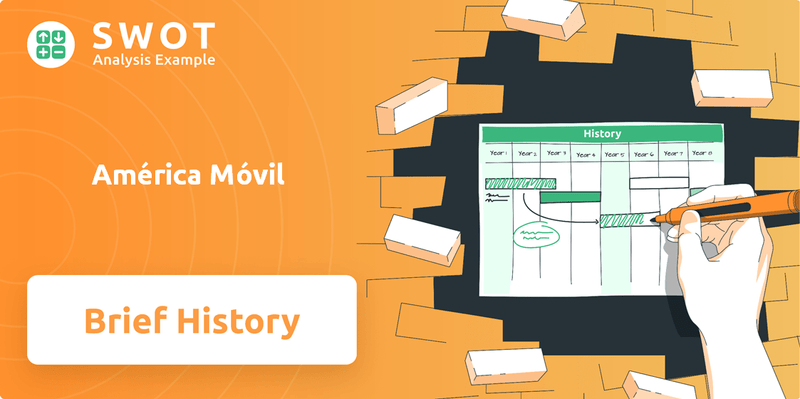
This brief history will explore the pivotal moments that shaped this Mexican company. From its early years to its expansive global footprint, we'll uncover the strategic moves and innovations that have defined América Móvil's success. Understanding the América Móvil history timeline is crucial for anyone interested in the company's impact on the Latin American market and its evolving competitive landscape.
What is the América Móvil Founding Story?
The founding of América Móvil, a significant telecommunications company, traces back to September 25, 2000. This date marks the official commencement of operations following a strategic spin-off from Telmex (Telefonos de Mexico).
The driving force behind América Móvil was Carlos Slim Helú, a prominent figure in the business world. His vision was to create a dedicated entity focused on the rapidly expanding mobile telecommunications market across Latin America. Slim's understanding of market dynamics was crucial in identifying the potential of mobile connectivity in the region.
The initial goal of América Móvil was to address the low penetration of mobile services and the fragmented telecommunications infrastructure in Latin America. The company aimed to consolidate services and expand network coverage to reach a broader population. Their original business model centered on providing wireless voice services, with a focus on prepaid plans to cater to the diverse economic conditions of the region's consumers. Their first offering was mobile telephony, leveraging the existing infrastructure and customer base from Telmex.
América Móvil was founded on September 25, 2000, as a spin-off from Telmex.
- Carlos Slim Helú spearheaded the creation of América Móvil.
- The company aimed to expand mobile services in Latin America.
- Initial funding came from assets transferred from Telmex.
- The focus was on wireless voice services, particularly prepaid plans.
América Móvil SWOT Analysis
- Complete SWOT Breakdown
- Fully Customizable
- Editable in Excel & Word
- Professional Formatting
- Investor-Ready Format
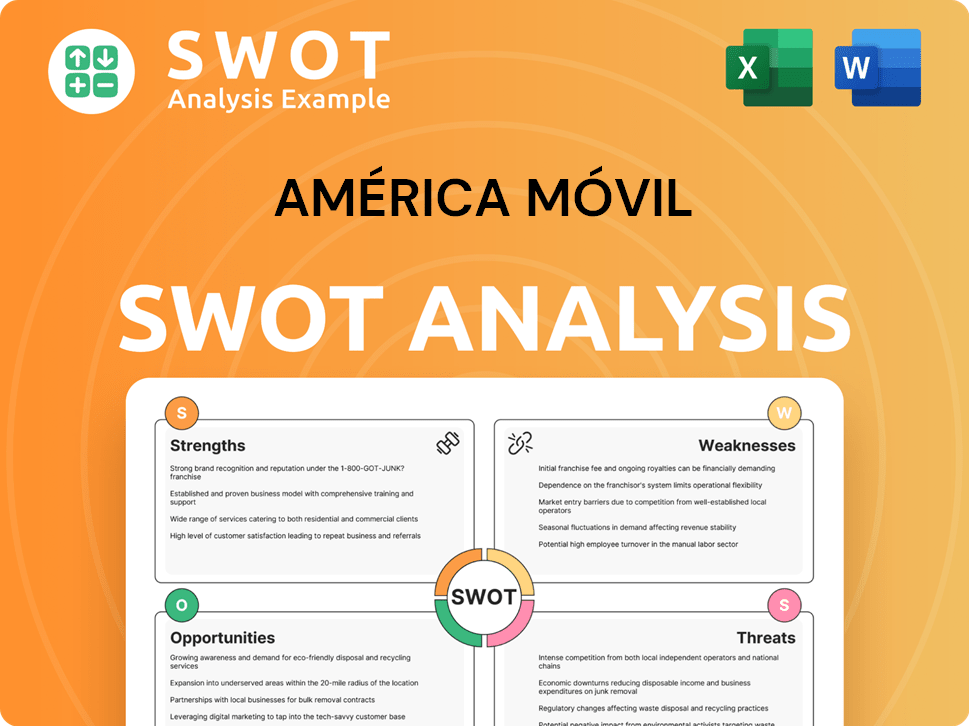
What Drove the Early Growth of América Móvil?
The early growth of América Móvil, a prominent telecommunications company, was marked by aggressive expansion and strategic acquisitions across Latin America. This period, following its spin-off in 2000, saw the Mexican company rapidly increasing its presence beyond its home market. Key to this growth was the acquisition of numerous mobile operators, significantly boosting its subscriber base and market share.
América Móvil's early years were defined by a robust acquisition strategy. The company quickly acquired controlling stakes in several key players, including Comcel in Colombia, Porta in Ecuador, and CTE in El Salvador. This approach allowed América Móvil to rapidly expand its footprint and subscriber base across the region, establishing a strong market presence. By 2004, América Móvil had a presence in over a dozen countries.
During this phase, América Móvil expanded its service offerings beyond basic mobile voice services. SMS and mobile data became increasingly important. Significant capital investments were made in network infrastructure to support the growing subscriber base and introduce new technologies like 3G. This focus on infrastructure was crucial for maintaining competitiveness.
A pivotal strategic shift involved moving towards integrated telecommunications services. Recognizing the convergence of fixed and mobile services, América Móvil began acquiring fixed-line assets. This laid the groundwork for its current comprehensive service portfolio. Despite intense competition, the company's aggressive expansion and focus on customer acquisition allowed it to establish a dominant position in the market. For a deeper understanding of the company's target market, consider reading about the Target Market of América Móvil.
By 2007, América Móvil had surpassed 100 million wireless subscribers, a testament to its successful early growth efforts. This rapid expansion solidified its position as a leading mobile services provider in Latin America. The company's ability to achieve cost efficiencies and offer competitive pricing further fueled its market share gains. This growth trajectory highlights the effectiveness of its early strategic decisions.
América Móvil PESTLE Analysis
- Covers All 6 PESTLE Categories
- No Research Needed – Save Hours of Work
- Built by Experts, Trusted by Consultants
- Instant Download, Ready to Use
- 100% Editable, Fully Customizable
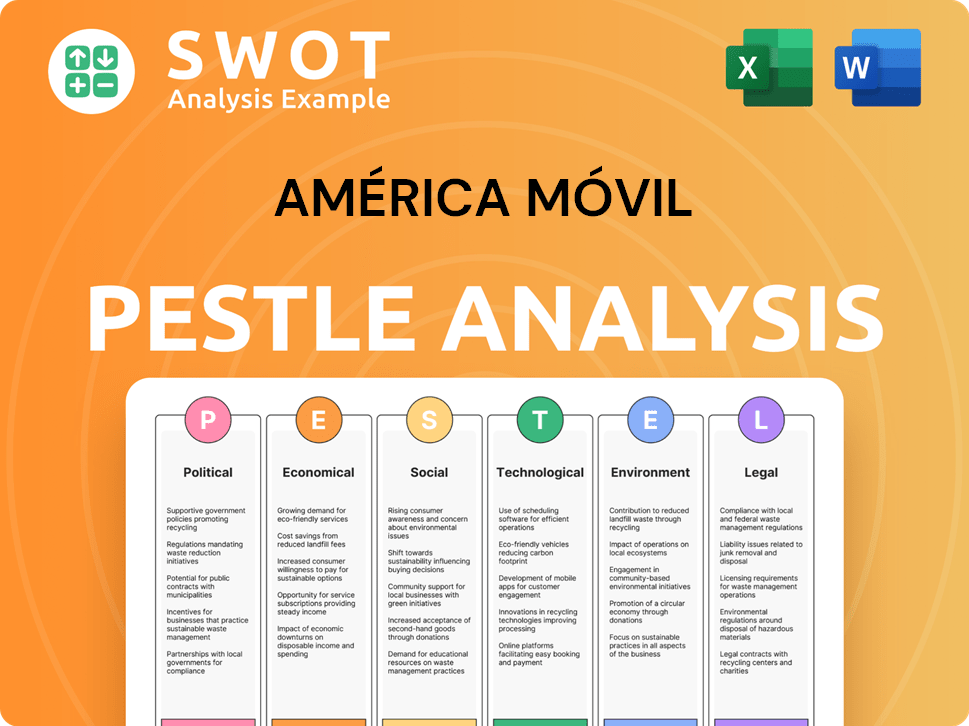
What are the key Milestones in América Móvil history?
The Brief history of América Móvil, a prominent telecommunications company, is marked by significant milestones that have shaped its trajectory. Its journey includes rapid expansion across Latin America, establishing a strong presence in multiple countries and becoming a leading Mexican company.
| Year | Milestone |
|---|---|
| Early 2000s | Rapid expansion across Latin America, establishing a dominant presence in multiple countries. |
| 2000s | Early adoption and innovation in bringing advanced mobile technologies, including 3G and 4G LTE networks, to the region. |
| Ongoing | Continuous investment in network upgrades, including the deployment of 5G technology. |
América Móvil has consistently introduced innovative mobile services and technologies to Latin America. It was an early adopter of advanced mobile technologies, significantly improving mobile broadband access for millions. The company has also focused on offering a diverse range of services, including fixed-line, broadband, and pay-TV, through strategic acquisitions and organic growth.
América Móvil was a pioneer in deploying 3G and 4G LTE networks across Latin America, enhancing mobile broadband access. This technological advancement significantly improved connectivity for millions of users, supporting the growing demand for mobile data and services.
The company expanded its offerings beyond mobile services to include fixed-line, broadband, and pay-TV. This diversification strategy allowed América Móvil to become a comprehensive telecommunications provider, catering to a broader customer base.
América Móvil has used strategic acquisitions to expand its footprint and service offerings. These acquisitions have been crucial in solidifying its market position and broadening its range of telecommunications services.
América Móvil is actively deploying 5G technology to maintain its competitive edge and meet the growing demand for data. This investment in advanced technology ensures that it remains at the forefront of the telecommunications industry.
América Móvil has faced several challenges, including regulatory scrutiny and increased competition. Regulatory measures, particularly in Mexico, have impacted its market dominance, leading to divestitures and changes in interconnection rates. The competitive landscape has also intensified, especially in mobile data and content streaming.
América Móvil has faced regulatory scrutiny, particularly in Mexico, where it has been subject to antitrust measures. These measures aimed to reduce its market dominance, impacting its operations and requiring strategic adjustments.
The telecommunications market has become highly competitive, with new entrants and existing players vying for market share. This competition, especially in mobile data and content streaming, has put pressure on América Móvil's market position.
América Móvil has navigated market downturns and economic volatility in various Latin American countries. These economic fluctuations have affected subscriber growth and revenue, requiring strategic adaptations.
In 2014, América Móvil was deemed a preponderant economic agent in Mexico, leading to stricter regulations. These regulations have influenced its operational strategies and market dynamics.
América Móvil Business Model Canvas
- Complete 9-Block Business Model Canvas
- Effortlessly Communicate Your Business Strategy
- Investor-Ready BMC Format
- 100% Editable and Customizable
- Clear and Structured Layout
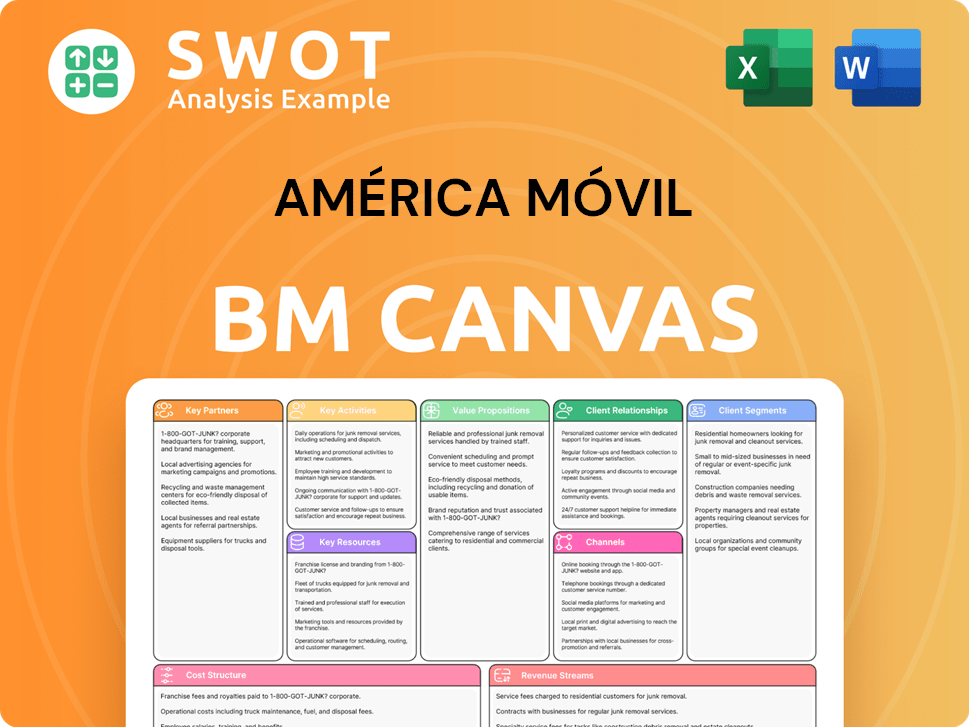
What is the Timeline of Key Events for América Móvil?
The Brief history of América Móvil, a prominent telecommunications company, is marked by strategic expansions and technological advancements. Founded in 2000 as a spin-off from Telmex, the Mexican company quickly established itself as a key player in the mobile services sector across Latin America. Under the leadership of Carlos Slim, América Móvil has grown significantly, adapting to industry changes and expanding its service offerings.
| Year | Key Event |
|---|---|
| 2000 | América Móvil officially spun off from Telmex, starting as a dedicated wireless telecommunications provider. |
| 2001-2004 | Rapid expansion across Latin America through strategic acquisitions of mobile operators in multiple countries. |
| 2007 | Surpassed 100 million wireless subscribers, solidifying its position as a leading regional player. |
| 2010 | Acquired Carso Global Telecom, integrating Telmex and Telcel operations more closely under the América Móvil umbrella. |
| 2012 | Became one of the world's largest telecommunications companies by subscribers. |
| 2014 | Declared a preponderant economic agent in Mexico, leading to increased regulatory scrutiny and divestment of assets. |
| 2017 | Launched Claro video, expanding its content offerings and venturing further into entertainment. |
| 2020 | Continued investments in network infrastructure and initiated 5G trials and deployments in select markets. |
| 2023 | Reported a strong financial performance with revenues of MXN 816.3 billion (approximately USD 48.7 billion) and an EBITDA of MXN 305.8 billion (approximately USD 18.2 billion). |
| 2024-2025 | Continued focus on 5G network expansion across its operational footprint and exploring new digital services. |
América Móvil is heavily invested in 5G technology, aiming to meet the increasing demand for high-speed data. This expansion involves significant capital expenditure on network infrastructure upgrades. The company plans to extend its 5G coverage across its operational areas to improve service quality and capacity.
The company is focusing on digital transformation by leveraging its large customer base. It intends to offer a broader range of digital services, including financial services and cloud solutions. This strategic move aims to diversify revenue streams and enhance customer engagement beyond traditional telecommunications.
The convergence of telecommunications, media, and technology sectors is influencing América Móvil's strategic direction. Data analytics and artificial intelligence are becoming increasingly important. Analyst predictions suggest continued growth in data consumption, supporting the company's core business and future growth.
América Móvil's leadership is committed to providing advanced connectivity and innovative solutions. This aligns with its founding vision of connecting people and businesses. The company's focus on 5G and digital services positions it to capitalize on future opportunities in the Latin American market.
América Móvil Porter's Five Forces Analysis
- Covers All 5 Competitive Forces in Detail
- Structured for Consultants, Students, and Founders
- 100% Editable in Microsoft Word & Excel
- Instant Digital Download – Use Immediately
- Compatible with Mac & PC – Fully Unlocked
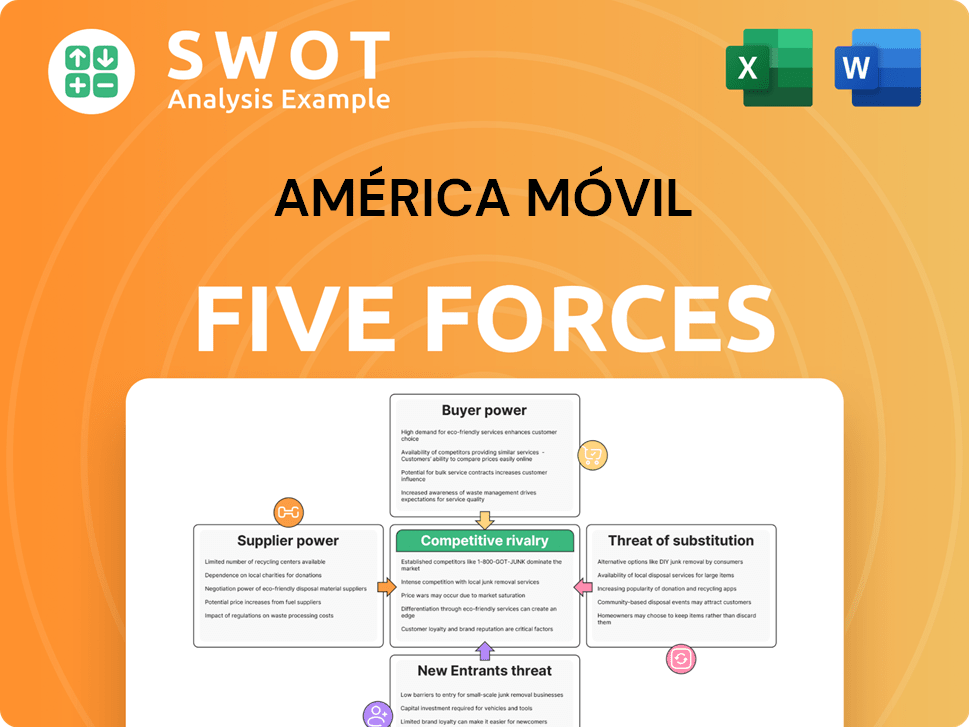
Related Blogs
- What is Competitive Landscape of América Móvil Company?
- What is Growth Strategy and Future Prospects of América Móvil Company?
- How Does América Móvil Company Work?
- What is Sales and Marketing Strategy of América Móvil Company?
- What is Brief History of América Móvil Company?
- Who Owns América Móvil Company?
- What is Customer Demographics and Target Market of América Móvil Company?
Disclaimer
All information, articles, and product details provided on this website are for general informational and educational purposes only. We do not claim any ownership over, nor do we intend to infringe upon, any trademarks, copyrights, logos, brand names, or other intellectual property mentioned or depicted on this site. Such intellectual property remains the property of its respective owners, and any references here are made solely for identification or informational purposes, without implying any affiliation, endorsement, or partnership.
We make no representations or warranties, express or implied, regarding the accuracy, completeness, or suitability of any content or products presented. Nothing on this website should be construed as legal, tax, investment, financial, medical, or other professional advice. In addition, no part of this site—including articles or product references—constitutes a solicitation, recommendation, endorsement, advertisement, or offer to buy or sell any securities, franchises, or other financial instruments, particularly in jurisdictions where such activity would be unlawful.
All content is of a general nature and may not address the specific circumstances of any individual or entity. It is not a substitute for professional advice or services. Any actions you take based on the information provided here are strictly at your own risk. You accept full responsibility for any decisions or outcomes arising from your use of this website and agree to release us from any liability in connection with your use of, or reliance upon, the content or products found herein.